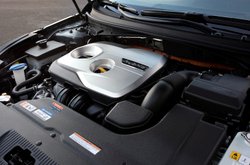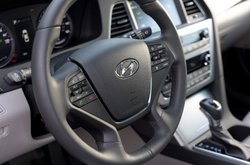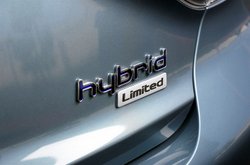An Electric Car on Training Wheels
In spite of low fuel prices in the U.S., Hyundai is moving forward in its quest to become the second-largest seller of green cars by 2020. It’s master plan is to produce 12 gasoline-electric hybrids, six plug-in electric hybrids and two battery electric vehicles.
In evidence is the 2017 Hyundai Sonata Plug-in Hybrid (PHEV).
Earlier, I reviewed the 2016 Sonata Hybrid and sang the praises of its hybrid system operation, smooth ride, road handling capabilities, extremely quite ride and the loads of standard equipment. The plug-in hybrid has all of those and more—a 27-mile pure electric driving range.
Sonata’s Plug-in Hybrid Drivetrain
Think of a plug-in hybrid as an electric car on training wheels. It has a larger battery than a standard hybrid vehicle, which allows it to travel on electric power for several miles. When the battery is depleted, it operates as a regular hybrid, eliminating the “range anxiety” of an electric vehicle.
Like an EV, the battery can be recharged via a common 120-volt household outlet, or for a faster charging time, a 240-volt home or roadside charging system.

The Sonata’s plug-in hybrid system includes the same gasoline engine as the hybrid: A direct injected 2.0-liter four with an output of 154 horsepower and 140 pounds-feet of torque.
Also like the hybrid, the plug-in version’s engine is connected to a six-speed automatic transmission with the torque converter replaced by an electric motor. The 50-kilowatt motor is 32 percent more powerful than the Sonata Hybrid’s and allows for electric-only operation at higher speeds.
Total combined system output—gas engine and electric motor—is 202 horsepower, which handily beats other popular PHEV sedans. The Chevrolet Volt has 149 hp and Ford’s Fusion Energi boasts 188 hp.
Hyundai’s reason for choosing an automatic transmission rather than the more common hybrid continuously variable transmission (CVT) was to address the complaint that hybrids were boring to drive.
Hyundai calls this design a Transmission-Mounted Electrical Device (TMED). Engineers refer to it as a parallel two-clutch system or P2. Its purpose is to blend power and efficiency, resulting in performance like a standard automobile’s automatic shifter.
The 2017 Sonata Plug-in Hybrid’s 9.8-kilowatt-hour lithium-ion polymer battery pack is more than five times larger than the hybrid model, which gives it the 27-mile electric driving range—

farther than any midsize PHEV.
While all hybrids, whether regular or plug-in, rely upon regenerative braking to add energy to the battery when slowing or stopping, Hyundai puts a spin on that with a “Charge” mode. It’s a charge-as-you-go feature that uses the engine to recharge the battery while driving on the highway.
At the end of the day, the EPA gives the Sonata Plug-in Hybrid a 39-mpg rating for the hybrid-only operation, and a 99 MPGe (miles-per-gallon equivalent) for the hybrid and electric systems combined.
Exterior and Cabin
Since the Sonata hybrids—both with and without a plug—pretty much mirror each other and the gasoline models they are derived from, I won’t repeat what I previously wrote, but there are some differences.
Both versions have an excellent low coefficient of drag of 0.24, which aids in fuel efficiency. The plug-in model has a unique grill and a charge port on the driver’s front side. Other PHEV touches include exclusive front fenders, front and rear lights, chrome side sill moldings, PHEV badging and “eco-spoke” aluminum wheels.

Inside there is a delicious amount of passenger space, front and rear, and the car sets a high standard for fit and finish and high-quality materials. A simple horizontal dash affords the driver access to controls that are easy-to-use, with proper buttons for basic functions such as audio entertainment, phone and navigation.
A distinctive instrument cluster with a 4.2-inch color LCD multi-purpose display lets drivers know the status and flow of the hybrid system. Center dash, a standard eight-inch touchscreen is one of easiest to use that you’ll find.
Hyundai has a knack for creating showroom appeal by including hot-button standard features. The base model includes a hands-free trunk lid, heated front seats, an eight-way power driver seat, dual-zone automatic climate control, Hyundai’s Blue Link infotainment system, rearview camera, a blind-spot monitor with rear cross-traffic alert and lane-change assist. Add to the list Apple CarPlay, Android Auto, Bluetooth connectivity, USB and auxiliary inputs along with HD and satellite radio.
The Limited model adds leather upholstery, ventilated front seats, a six-way power front passenger seat, a heated steering wheel and an Infinity sound system. Added safety features include adaptive cruise control, a forward collision warning system, lane-departure warning and rear parking sensors.
Behind the Steering Wheel
Like the non-plug hybrid, the 2017 Hyundai Sonata Plug-in Hybrid was a soothing respite from the bustle and hubbub of city traffic—nicely soundproofed, luxuriously appointed and pleasant to drive. Get up to speed from a stop via the gas engine, ease off the accelerator and the transition to electric power was uncannily smooth and allowed all-electric driving for several miles.
Merging onto a fast-moving freeway, I mashed the accelerator, and the six-speed transmission wound nicely toward top rpms, shifting each time somewhere around 6,000 rpm, when the full tug of torque seemed ready to run out. So it would seem that Hyundai’s goal of achieving a driving experience that closely parallels a conventional car is accomplished.

As for handling, the car’s chassis had a balanced agility and the suspension kept everything secure. The ride was composed and comfortable with the suspension soaking up potholes and rough pavement.
The electric power steering lacked feedback, but always steered the car where I wanted it go and was balanced and firm, never twitchy.
Unlike the hybrid version, the plug-in’s brakes felt natural without a squishy feel and promptly slowed and stopped the car according to brake pedal pressure.
There is a downside to the plug-in version—trunk space. The large battery located in the trunk shrinks space to just 9.9 cubic feet. That compares to gasoline models with 16.3 cubic feet and the hybrid model with a livable 13.3 cubic feet.
My advice, don’t pickup folks at an airport with lots of luggage, unless they don’t mind having some on their lap.
I did use the “Charge” mode on a freeway trip and it added 19 miles of all-electric driving, but I don’t think it’s an efficient method. It seems to me the battery hold mode on the Chevy Volt makes more sense.
After a week, we returned the 2017 Hyundai Sonata Plug-in Hybrid with an additional 277 miles on the odometer. The miles were split 40-percent highway/60-percent city and the electronic readout showed an overall average of 101 MPGe.
In The Marketplace
Chevrolet’s Volt has an EPA all-electric driving range of an exceptional 53 miles, but it’s a much smaller car and is really only suited for four adults. That leaves the Ford Fusion Energi as the only true competitor for the Sonata Plug-in Hybrid.
Hybrids and PHEVs command a price premium compared to their comparable gasoline powered models. The Fusion Energi is priced from $33,900 plus destination charges for the base model to $36,435 for the top of line Titanium. It’s EPA rated at 42 mpg for hybrid driving and 97 MPGe for hybrid and electric combined.
Something Hyundai stands behind
The plug-in Sonata base model has a sticker price of $34,600, while our Limited (with 3 mpg less, but 2 MPGe more than the Fusion Energi) came in at $38,600.

With the price of gasoline, at the moment neither seems like an intelligent purchase. However, one has to remember, when it comes fuel prices, what goes down will go up.
Choosing between the Ford and Hyundai appears on the surface to boil down to a flip of a coin. However, the Hyundai Sonata Plug-in Hybrid does have a couple of aces in the hole.
First, because it has a larger battery, the plug-in Sonata is eligible for a $4,919 federal tax credit compared with the Fusion Energi’s $4,007, essentially evening the price.
But the 2017 Hyundai Sonata Plug-in Hybrid offers something that Ford can’t match—Hyundai’s basic warranty coverage of five years/60,000 miles bumper-to-bumper and 10 years/100,000 miles powertrain.
Then there’s the warranty knockout punch—the Lifetime Hybrid Battery Guarantee. If the lithium-polymer battery fails, Hyundai will replace the battery and cover recycling costs of the old battery pack free of charge to the original owner.
For those who see the value of a plug-in hybrid, the warranty just might tilt the buying decision to the Hyundai Sonata Plug-in Hybrid.
Related Stories You Might Enjoy:
Road Test: 2017 Chevrolet Volt
Road Test: 2017 Honda Accord Hybrid
Road Test: 2016 Hyundai Sonata Hybrid
Road Test: 2016 Kia Optima Hybrid
Road Test: 2016 Toyota Camry Hybrid
Disclosure:
Clean Fleet Report is loaned free test vehicles from automakers to evaluate, typically for a week at a time. Our road tests are based on this one-week drive of a new vehicle. Because of this we don’t address issues such as long-term reliability or total cost of ownership. In addition we are often invited to manufacturer events highlighting new vehicles or technology. As part of these events we may be offered free transportation, lodging or meals. We do our best to present our unvarnished evaluations of vehicles and news irrespective of these inducements.
Our focus is on vehicles that offer the best fuel economy in their class. We also feature those that are among the top mpg vehicles in their class. In addition, we aim to offer reviews and news on advanced technology and the alternative fuel vehicle market. We welcome any feedback from vehicle owners and are dedicated to providing a forum for alternative viewpoints. Please let us know your views at publisher@cleanfleetreport.com.

15 thoughts on “Road Test: 2017 Hyundai Sonata Plug-in Hybrid”